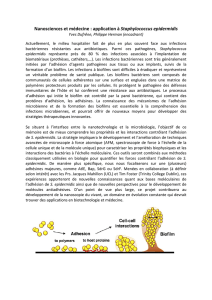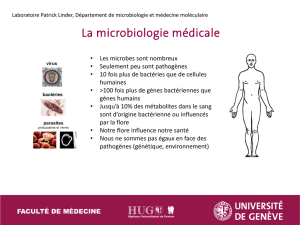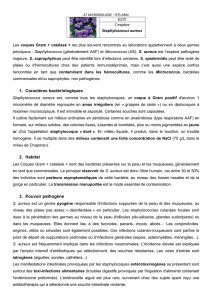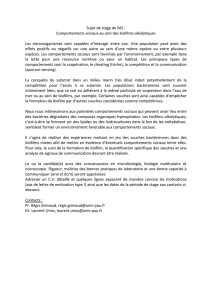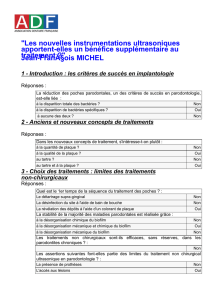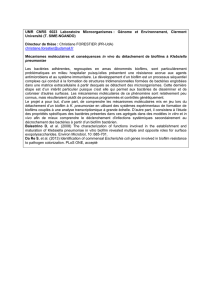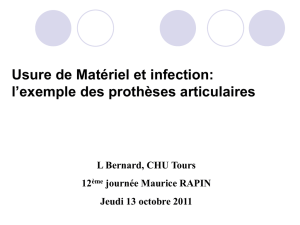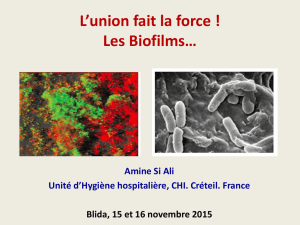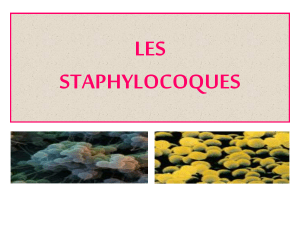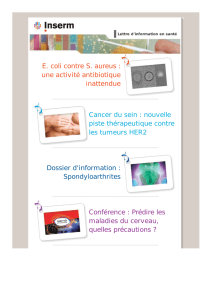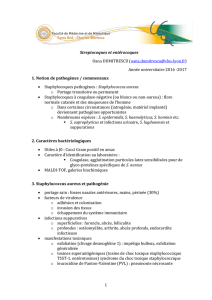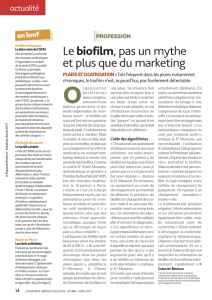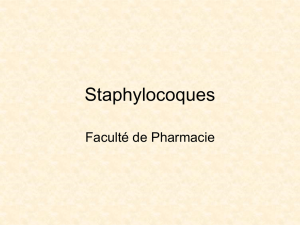S. aureus
publicité
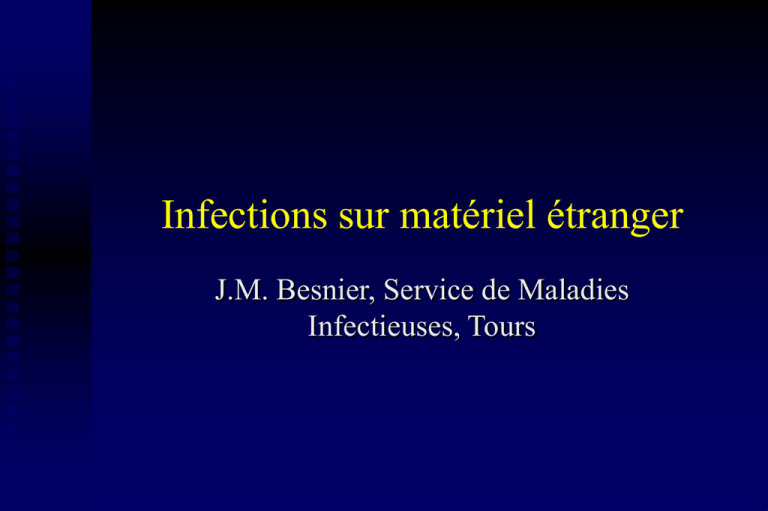
Infections sur matériel étranger J.M. Besnier, Service de Maladies Infectieuses, Tours Incidences Infections sur prothèse valvulaire cardiaque 1 à 3% (12 mois post-opératoire) 3 à 5,7% (60 mois post-opératoire) Infections sur sonde de pacemaker 0,8 à 4,9% Infection sur prothèse artérielle Aorto-fémorale : 0,5 à 3% Fémoro-fémorale ou poplitée : 2 à 5% Prothèse ostéo-articulaire Hanche : < 1% Genou : 2,9% Infections sur prothèses ostéo-articulaires Microbiologie des endocardites Microorganisme (%) Valve native Streptococcus sp S. viridans S. bovis I S. aureus SCN Enterococcus Champignons Cultures négatives et HACEK 30-45 Valve prothétique < 60 j > 1 an 1 30-33 25 - 30 3-5 14 - 17 2 20-24 30-35 5-8 5 - 10 5 3-7 En France 1991 1999 15-20 10-12 8 - 12 1 58 27 23 18 5 - 58 17 25 23 6 - 3-8 - - Microbiologie des infections sur prothèse vasculaire Prothèses Aortoiliaques Aortofémorales S. aureus S. epidermidis Autres cocci Anaérobies Entérobactéries Cultures négatives 5 6 10 17 55 6 24 27 13 39 5 Microbiologie des infections sur prothèse ostéo-articulaire Berbari (n=462) 1969-1991 S. aureus 101 (22%) SCN 86 (19) Streptocoques 42 (9) Bacilles Gram - 38 (8) Anaérobies 29 (6) Culture 38 (8) Autres 21 (5) Polymicrobien 88 (19) Steckelberg (n=1023) 1969-1991 240 (23) 254 (25) 79 (8) 114 (11) 62 (6) 83 (8) 54 (5) 147 (14) Tsukayama (n=106) 1980-1991 33 (31) 56 (53) 14 (13) 21 (20) 12 (11) 3 (3) 11 (10) 27 (25)* Infections sur cathéter central Epidémiologie 20 à 70% des bactériémies nosocomiales 1 à 9,6 bactériémies liées aux cathéters/1000 jrs-cathéter Mortalité attribuable 12 à 25% Microorganismes en cause SCN S. aureus Champignons KES 27% 26% 17% 16% Infections sur matériel étranger Physiopathologie Mode de contamination Facteurs de l’hôte Facteurs bactériens : protéines de surface Facteurs liés au matériau Diagnostic Prise en charge thérapeutique Prévention Physiopathologie : mode de contamination Per-opératoire Post-opératoire précoce (cicatrice) Post-opératoire tardif (hématogène) Réservoir de la bactérie en cause ? Exogène Endogène : relation entre colonisation / portage nasal et Bactériémie (NEJM, Von Eiff, 2001) Infection après chirurgie cardio-thoracique (JID, Kluytmans, 1995) Infection après chirurgie orthopédique (ICHE, Kalmeijer, 2001) Infection de pacemaker (Circulation, Da Costa, 1998) Physiopathologie : facteurs de l’hôte Absence de réponse humorale efficace et spécifique Altération de l’activité phagocytaire Diminution de l’activité opsonisante Dégranulation des PMN Diminution de l’activité bactéricide (germes catalase +, production d’ion superoxyde) Diminution de production de cytokines (TNF) Malgré l’afflux de PMN (bactérie/PMN = 1/100 à 1/50 000) Effet protecteur de l’administration locale de PMN Diminution de production d’IFN-γ ? Modèle cage Pathogénie de l’infection sur matériel Mesure de l’activité bactéricide des PNN 1 à 2 semaines après implantation % killing 80 70 60 50 40 30 20 10 0 0 S. aureus/PNN cage S. aureus/PNN péritoine 1 heure 2 incubation E. faecalis/PNN cage E. faecalis/PNN péritoine Physiopathologie : facteurs de l’hôte • Modèle infection sur cathéter souscutané • S. epidermidis RP62A • Traitement IFN sous-cutané x 3/sem • Compte cfu après 2 semaines (Boelens, JID, 2000; 181:1167-71) Physiopathologie : facteurs de l’hôte Cytokines Production de TNF, IL10 et IFN-γ par cellules mononucléées, en réponse à S. aureus Control Patient TNF IL-10 IFN-γ 6598 pg 235 pg 3,2 IU 12 885 1036 < 0,08 (Honstettre, JCM, 2003; 41:5344-6) De l’adhérence au biofilm UN des aspects de la physiopathologie des infections sur prothèse Intérêt pour le diagnostic des infections ? Sonication, trypsinisation ... Intérêt pour le traitement des infections Intérêt pour la prévention des infections ? matériau, sub-inhibitrices d’antibiotiques, Inhibition de l’adhérence concentrations De l’adhérence au biofilm (Marshall, ASM News 1992 ; 58 : 202-207) Le biofilm (Gristina, Science 1987 ; 237 : 1588-1595) «Proteinaceous adhesins (fimbriae in Gram-negative bacteria), polysaccharides polymers, and surface and milieu substances interact and intermix to form an aggregate of bacteria, elemental substances, glycoproteins, and polysaccharides in a biofilm» …or «a microbially derived sessile community characterized by cells that are attached to a substratum or interface or to each other, are embedded in a matrix of extracellular polymeric substances that they have produced, and exhibit an altered phenotype with respect to growth rate and gene transcription » (Donlan et Costerton, Clin Microbiol Rev, 2002) De l’adhérence au biofilm (Gristina, Science 1987 ; 237 : 1588-1595) Charge électrique Forces Van der Waals Hydrophobicité Protéines de surface Protéines de l’hôte (récepteurs) Cellules ? (plaquettes, hématies ...) Absorbance (590 nm) Rôle de l’hydrophobicité 0,5 0,4 0,3 0,2 0,1 0 Hydrophobe Hydrophile 0 1 2 3 Temps (heures) 4 Attachement et adhésion S. aureus Adhésines bactériennes Protéine liant la fibronectine Clumping factor Protéine liant le collagène Protéine liant la thrombospondine Autres protéines ? Protéines de l’hôte Fibronectine Fibrinogène Collagène Thrombospondine Laminine, vitronectine ... Attachement et adhésion Staphylocoques à coagulase négative (1) Adhésines bactériennes Adhésine capsulaire PS/A Protéines de l’hôte ? Vitronectine Hématie (Muller, 1993) Protéine 220 kDa (Timmerman, 1991) Autolysine (atlE) Hémagglutinine ou lectine (Rupp, 1992, 1995) Attachement et adhésion Staphylocoques à coagulase négative (2) Acide lipoteichoïque ? Plaquettes ? Protéine liant la fibronectine ? Fibronectine Protéine liant le fibrinogène ? Fibrinogène 119 kDa Peu homologie avec CF de S. aureus Ubiquitaire Activité fonctionnelle hétérogène Autolysine de S. epidermidis gène atlE Protéine 1335 AA 148 kDa Protéine de surface Rôle des protéines de l’hôte Rôle Majeur Rôle secondaire Fibrinogène (Strepto, S. aureus >> SCN) Fibronectine (S. aureus >> S. epi) Laminine (Strepto, S. aureus, SCN) Albumine, sérum Plaquettes Thrombospondine D-Mannosamine De l’adhérence au biofilm (Gristina, Science 1987 ; 237 : 1588-1595) Slime (ou glycocalyx ou exopolysaccharide) Adhésine inter-cellulaire (PIA)* Souches Hc (85% PIA +) Souches saprophytes (6%) * : Ziebuhr, Infect Immun 1997 Aggrégation et colonisation (1) PIA (Fey, 1999; Dietrich,1999) Slime Exopolysaccharide (glucose, ph. glycérol, N-acétyl-glucosamine, ala, ac uronique, ...) Ag polysaccharidique (Mack, 1996) Protéine 140 kDa (Hussain, 1997) Variation phénotypique Variation de phase Adhésion des bactéries entre elles Aggrégation et colonisation (2) PIA (Polysaccharide Intercellular Adhesin) Polymère b-1,6-N-acetyl glucosamine Responsable de l’autoaggrégation des bactéries et de l’hémagglutination Sous la dépendance d’un opéron icaABCD Relation PIA et biofilm 87% SE biofilm + 88% SE biofilm - PIA + PIA - Modèle infection cathéter à S. epidermidis(1) Colonisation cathéter S. epidermidis O-47 : biofilm + S. epidermidis O-47 mut1 : AtlE S. epidermidis O-47 mut2 : PIA - Hémocultures positives (JID 2001; 183: 1038-42) Modèle infection cathéter à S. epidermidis(2) SE O-47 Rein Foie Cœur Poumon 7/8* 1,49x103** SE AtlE - SE PIA - 4/8 2,34x102 3/8 0 7/8 2,7x104 3/8 0 3/8 0 5/8 1,6x102 3/8 0 3/8 0 7/8 1,4x104 4/8 5,1x103 4/8 8,4x103 * : N rats intectés/total - **: médiane cfu/g (JID 2001; 183: 1038-42) Facteurs de virulence chez S. aureus agr Adhésines + Facteurs d’invasion/dissémination Phase stationnaire Phase exponentielle CNA Clumping factor ? FnBP Protéine A Coagulase Hémolysines Toxines Clumping factor ? + + sar Pathogénie des infections sur matériel P h. e x p o n. P h. s t a t i o n. agrA,C,D,B Octapeptide (Signal de densité cellulaire peptide auto-induit AIP) ARNIII Toxine d Exoprotéines •Souches S. aureus agr- plus productrices de biofilm que agr+* •Souches agr+ (avantage infections aiguës) vs agr- (avantage infections chron) •Octapeptide de S. epidermidis inhibiteur du système agr de S. aureus (avantage sélectif au niveau cutané ?)** * : Vuong et al. JID 2000 ; ** : Otto et al. Infect Immun 2001 Facteurs Facteurs de pathogénicité de pathogénicité (système (exoprotéines) agr, 3) 3. Fonctionnalité du système agr : gène hld exoprotéines 35 [bactérie] x 10^7 ufc 30 protéines de surface 25 20 souche n°1 + 15 - 10 souche n°2 Régulation par le système agr 5 0 0 2 4 6 8 10 Temps en heure agr +: expression de la delta-hémolysine après 8h agr -: pas d’expression Système agr fonctionnel Autre mécanisme de quorum-sensing • RAP : RNA III-activating Peptide • Protéine TRAP (Giacometti, AAC 2003, 47 : 1979) Pathogénie des infections sur matériel S. epidermidis PIA et formation de biofilm Opéron ica Souches ica + 85% souches d’hémocultures vs 6% souches cutanées* 77% souches d’hémocultures vs 37% souches cutanées** 81% souches infection prothèses vs 17% souches saprophytes*** * : Ziebuhr et al. Inf Immun 1997 ** : Barbier-Frebourg et al. J Clin Microbiol 2000 *** : Galdbart et al. JID 2000 S. aureus Opéron ica chez toutes les souches Facteurs de virulence Protéine liaison au collagène Liaison à la sialoprotéine Toxines a et g Leukocidine de PantonValentine Facteurs de pathogénicité (biofilm, 1) 1. Prévalence des gènes impliqués dans la formation du biofilm 1400 pb 989 pb 526 pb 814 pb icaC icaB icaA Gènes détectés Écosystème d’origine Opéron ica fbe atlE Infection de prothèse (écosystème A) 6 (54%)* 11 (100%) 11 (100%) Saprophyte chirurgien (écosystème B) 2 (8%) 25 (100%) 25 (100%) Saprophyte malade (écosystème C) 7 (23%) 30 (100%) 30 (100%) * : p=0.036 Facteurs de virulence de S. epidermidis Infection sur prothèse cna fnbA Sialoprotéine fbe ica opéron Biofilm Souches pts Souches porteurs (n=54 souches/14 pts) (n=23 souches/8 sujets) 0 0 1 54 44 (81,5%) 34 (63%) 0 0 5 23 4 (17,4%) 2 (8,6%) p < 0.01 < 0.05 Galdbart et al. JID 2000 Résultats : Diversité génétique des isolats Résultats : Lien génétique entre les isolats Ecosystème d’origine Infection de prothèse (n=11) I Groupe RAPD* II III IV 9 (82%) 0 2 0 18 (72%) 4 3 0 9 16 (53%) 2 3 Saprophyte chirurgiens (n=25) Saprophytes Malades (n=30) * : p = 0,0012 Propriétés du biofilm Diminution de vitesse de pénétration des AB (Ciprofloxacine et biofilm de P. aeruginosa, AAC 1994) Moindre sensibilité aux antibiotiques diffusion grosses molécules (AB, enzymes, complément) diffusion glucose et O2 (AAC, Anderl, 2003) (K pneumoniae) Expression de gènes de résistance (Trampuz, Clin Orthop 2003; 414:69-98) Minimum bactericidal concentration (MBC) of Staphylococcus epidermidis B3972 Phases of bacterial growth (µg/ml) Antibiotic Logarithmic Stationnary Fold increase Vancomycin 4 50 12.5 Daptomycin 2 12.5 6 Teicoplanin 4 12.5 3 Ciprofloxacin 0.5 100 200 Rifampicin 0.06 0.15 2.5 Netilmicin 8 400 50 (Widmer et al. JID, 1990) Cure rate of tissue-cage infections with Staphylococcus epidermidis B3972 0 10 20 30 40 50 60 70 80 90 100 % Daptomycin 5 17 Daptomycin 5 + Netilmicin 20 Teicoplanin 6,6 75 0 Vancomycin 15 17 Vancomycin 15 + Netilmicin 20 Ciprofloxacin 10 25 0 Ciprofloxacin 10 + Rifampin 7,5 Rifampin 7,5 Rifampin 25 (Widmer et al. JID, 1990) 100 75 100 Killing of glass-adherent E. Coli ATCC 25922 CFU / slide (mean SE) Drug Controls After treatment % killing Cotrimoxazole Aztreonam Fleroxacin Ciprofloxacin 153 19 241 17 338 10 531 56 (Widmer et al. AAC, 1991) 576 129 14 7 39 20 00 0 94.3 88.4 > 99.9 Log killing 0 1.25 0.93 >3 Physiopathologie : facteurs liés au matériau Cathéters Silicone +++ Polychlorure de vinyle, polyuréthane, ++ polytétrafluoroéthylène Métal + Titane – Polymethylméthacrylate + Hydroxyapatite ++ Implants orthopédiques Physiopathologie : facteurs liés au matériau activité bactéricide PMN production superoxyde prolifération LB et LT IL2, IL6 (Monocytes) activité ostéoclastique IL1, IL6, TNF (ostéoblastes) activité ostéoblastique Ostéocalcine, collagène I (ostéoblastes) Résorption osseuse péri-prothétique Susceptibilité à l’infection Diagnostic microbiologique des infections sur matériel Difficile Faussement négatif Traitement antibiotique antérieur Inoculum faible Milieux inadaptés ou germes fastidieux Faussement positif : Contamination : après prélèvement ou si prélèvement inapproprié Difficultés d’interprétation (SCN) Negative cultures Does it exclude the diagnosis of infection ? DISCUSSION Antibiotics should have been stopped (2 weeks) Sample Aspiration of the joint Peri-operative samples Other criteria : histology, molecular technique ? Positive culture(s) Is it always an infection ? Is the isolated bacteria the causative bacteria ? DISCUSSION Sample Sinus tract aspiration Aspiration of the joint Peri-operative samples Number of positive samples Species Negative cultures Joint fluid aspiration Spangehl et al. 1999 Negative predictive value 98% and sensitivity 85% 3 of 21 pts with a true infection had negative culture of joint fluid aspiration Repeat aspiration or revision arthroplasty, according to other symptoms ESR (30 mm/h) + CRP (10 mg/l) + negative joint fluid aspiration : NPV 100% !!! Negative cultures Per-operative samples Antibiotics < 2 weeks ? Are there non culturable bacteria ? Are bacteria not dislodged from prosthesis ? Are other techniques necessary ? Sonication Molecular techniques Evaluation of sonication and molecular technique (1) 120 patients for total hip revision surgery Standard culture vs culture of sonicate samples from prosthesis vs 16SrRNA gene amplification vs histology Standard culture Culture of sonicate 16SrRNA PCR Score PMN > 1/HPF N samples N positive samples % positive samples 120 120 118 81 5 25 85 59 4 22 72 73 Tunney et al. 1999 Evaluation of sonication and molecular technique (2) All the 25 positive cultures were PCR positive S. aureus (1) CNS (14) P. acnes (15) 60 patients with negative cultures were PCR positive Contaminating bacterial DNA excluded since the lower limit of detection was 104 cfu/ml Tunney et al. 1999 Positive culture Sinus tract aspiration Diagnostic value of sinus-tract cultures in chronic osteomyelitis (Mackowiak et al. JAMA, 1978) Positive predictive value S. aureus Enterobacteria Ps. aeruginosa Streptococcus 78% 29% 8% 19% Only 44% of sinus tract cultures from patients with S. aureus osteomyelitis yielded this bacteria Case report W, 69 years-old 2nd Hip prosthesis (02/93) Hip pain Sinus tract infection (01/99) Sinus tract aspirations S. aureus (SAMS) Prosthesis removal (05/00) S. aureus (SAMS) 1/5 sample S. epidermidis (SEMS) 5/5 samples Positive culture Joint fluid aspiration Prospective analysis of pre-operative (and intraoperative) investigations for the diagnosis of hip prosthesis infection (Spangehl et al. JBJS[A], 1999) Positive predictive value (180 pts) Initial aspiration : Repeated aspiration : 67% (CI95 : 46-83) 77% (CI95 : 54-91) False positive results : 33% Repeat joint aspiration or surgery ? according to clinical, biological, radiographic, scintigraphic manifestations Positive cultures Per-operative samples Is histology contributive ? Is the number of positive samples contributive ? Does species influence interpretation of results ? Does histology contribute to the diagnosis ? (1) Charosky et al. 1973 Acute inflammation (PMN) in 8/12 infected prosthesis vs 2/8 aseptic loosening Chronic inflammation (L, Pc) in all but one patient (19/20) Mirra et al. 1976 Acute inflammation (> 5 PMN per HPF x 500) in 15/15 infected prosthesis* vs none in 21 non infected prosthesis Chronic inflammation (> 10 L, Pc per HPF) in 14/15 infected prosthesis vs 6/21 non infected prosthesis * : 10 of them developped < 3 months after prosthesis insertion and bacteria were Ps aeruginosa (7), S. aureus (1), Enterobacteriacae (7), Streptococcus, Micrococcus (3) Does histology contribute to the diagnosis ? (2) Pandey et al., 1998 79 septic vs 523 aseptic loosening Acute inflammation* > 1 - 5 PMN/HPF > 5 PMN/HPF Chronic PPV NPV 92% 100 100% 97 25 44 91 89 inflammation* > 1 - 5 L/HPF > 5 L/HPF * : Mean number of cells after examination of 10 HPF (x400) Number of positive samples N positive specimens 3 2 1 Histology + 27 19 2 5 1 1 6 42 * : compared with histology (> 5 PMN/HPF) ** : whatever the microorganism *** : for CNS PPV (%)* 96,4** 95 *** 25,2 10,6 Atkins et al. 1998 Does species influence interpretation of results ? OUI si SCN (S. epidermidis) Antibiogramme sur tous les isolats Eventuellement techniques moléculaires (RAPD, Champ pulsé) Infection monoclonale, malgré diversité des profils de sensibilité (Galbart, JCM, 1999;37:1306-12) Infection polyclonale n’exclut pas le diagnostic d’infection Souches étudiées 1 TISSU 2 TISSU 3 TISSU 4 TISSU hanche G hanche G hanche G hanche G 5 TISSU hanche G 6 TISSU hanche G 7 TISSU hanche G 5/12/03 5/12/03 5/12/03 5/12/03 S. capitis S. epidermidis S. epidermidis var 1 S. epidermidis var 2 11/7/03 S. capitis 11/7/03 S. capitis 11/7/03 S. capitis M 1 2 3 4 5 6 7 Rules for bacterial diagnosis Multiple samples from different sites (5-6 samples) Joint fluid Capsular material femoral and acetabular or tibial pseudomembranes Other (pus, granulation tissue ...) Separate instruments Histological examination Microbiological cultures « small colony variant » difficulté de détection Normale Small colony variant Von Eiff C «small colony variant» résistant aux antibiotiques aminoglycosides, bétalactamines, glycopeptides, fluoroquinolones Bactéricidie Native Mutant Prise en charge thérapeutique des infections sur matériel : Prothèses OA Infection post-opératoire précoce (≤ 4 semaines) Infection post-opératoire tardive (> 4 semaines) Changement prothèse Antibiothérapie systémique Infection aiguë hématogène ou secondaire Arthrotomie-lavage Antibiothérapie systémique Arthrotomie-lavage Antibiothérapie systémique Prélèvements per-opératoires isolément positifs Antibiothérapie systémique (Tsukayama, JBJS 1996; 78-A: 512-23) Prise en charge thérapeutique des infections sur matériel : Pacemaker Infection loge PM (Hc - / ETO -) Ablation PM* AB 2 semaines Réimplantation J15 avec ABaxie Vanco Infection sonde PM Hc +/ ETO Soit ablation PM* Soit AB 6 semaines Hc + / ETO + Ablation PM* (Boitiers AB 4 - 6 semaines Réimplantation + sondes) Non justifiée ? Immédiate : PM épicardique Différée : PM endovasculaire controlat à J15 * : Traction externe ou chirurgie, selon ancienneté PM et taille végétation (10 mm?) ? Inhibition de la formation de biofilm • RAP : RNA III-activating Peptide • Protéine TRAP (Giacometti, AAC, 2003; 47:1979) Inhibition de la formation de biofilm (Giacometti, AAC, 2003; 47:1979) Inhibition de la formation de biofilm (Giacometti, AAC, 2003; 47:1979) Prévention des infections sur cathéter Choix du cathéter Polyuréthane Surface «ultra-lisse» Hydrophile Antiseptiques Chlorhexidine + sulfadiazine-Argent Antibiotiques Vancomycine, oxacilline clindamycine minocycline rifampicine céfazoline Héparine, benzalkonium Cathéter chlorhexidine + sulfadiazine-Argent Colonisation (%) Témoin CG-SA Bactériémie Témoin CG-SA Maki, 1997 (n=403) Tout germe SCN 24 17 13,5* 11,5 7,6 1,6* Heard, 1998 (n=308) Tout germe 52 40* 3,8 3,3 * : p < 0.05 Cathéter minocycline + rifampicine Colonisation (%) Bactériémie** Témoin M-R Témoin M-R Raad, 1997 (n=281) Tout germe 26 S. epidermidis 12 8* 2* 7,34 0* Darouiche, 1999*** (n=738) Tout germe 24 SCN 18 5,3* 4* 4,1 0,3* * : p < 0.05 ; ** : bactériémies/1000 jours-cathéter ; *** : vs CG-SA Cathéters antibiotiques ou antiseptiques Indications ? Nécessité de prendre en compte Risque d’émergence de résistance (rifampicine, minocycline) Risque de réactions allergiques (chlorhexidine) Durée prévisible de cathétérisme (> 7 jours) Coût Prévention des infections sur cathéter Futur ? Cathéters négativement chargés Héparine, liée de façon covalente Inhibition de la formation du biofilm (PIA)
